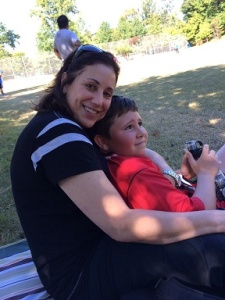When I was 14 years old, my father died at age 41 of massive pulmonary emboli (PE). At that time, there was no genetic testing to determine if he had a clotting disorder. I am 49 years old now, and I survived bilateral pulmonary emboli (PE) with deep vein thrombosis (DVT) one year ago.
14 years old, my father died at age 41 of massive pulmonary emboli (PE). At that time, there was no genetic testing to determine if he had a clotting disorder. I am 49 years old now, and I survived bilateral pulmonary emboli (PE) with deep vein thrombosis (DVT) one year ago.
I was putting in many hours on what I thought was an important project at work, and I was feeling run-down. I had developed a cough that I couldn’t seem to shake. My leg began to hurt, but I didn’t recall injuring myself. I had a nagging memory that my father’s leg had swelled just before he died, but I brushed it off. After a week of ignoring my symptoms, I finally went to the doctor. By this time, my breathing was labored, and I shared the newest symptom of the pain in my leg. I was told to go to the emergency room because the clinic was not equipped to perform a CT scan. At first, I didn’t take the doctor seriously, until she asked me to sign a waiver stating that I had been told to go to the ER. I believed it was a waste of time, I thought that I simply had bronchitis, but I went nonetheless.
I was amazed at how quickly my whole world changed. The doctor came in to the room where I sat waiting, wearing an ugly hospital gown and texting with my office. Everything was happening so fast, yet I felt like the doctor was speaking very slowly. I don’t remember all of the words he said, but I do recall the words “pulmonary emboli” and “deep vein thrombosis.” I didn’t know what a DVT was exactly. However, I knew all too well what PE meant: My father had lost his life to a PE many years ago. Blood clots that had developed in my left leg were breaking off and traveling to my lungs. I was admitted to the hospital to be stabilized in the intensive care unit. I was terrified and my mind was spinning. There were so many doctors and so many tests. I remained hospitalized for five days.
I had nightmares after I was released. There is not a lot of information available about recovery and what to expect. It took a few months for the weight of everything that had happened to sink in and for me to cope with it all. I was emotional and often depressed. I learned that I have a genetic disorder called Factor-V Leiden, as well as two other gene mutations called Lupus Anticoagulant and MTHFR (methylenetetrahydrofolate reductase). There were signs long before this happened, but I didn’t know what they were. I had a miscarriage in my twenties, which can occur in women with clotting issues.
It’s been more than a year since I experienced my PE, and I’m happy, well, and alive. Most of all, I am thankful. My leg still gets swollen when I am standing for too long or I walk a lot. I still have breathing problems at times, mostly when I am exercising. I am hyper-aware of every change in my body, and I often worry that I’ll get another clot. I will take blood thinners for the rest of my life, but that’s okay. It’s just a pill. My life is very different now and this has changed me forever. I don’t work as much as I used to, and I spend more time living my life, trying to be a better friend, sibling and niece. I am enjoying my life and forcing myself to get out and participate in the world and not hide in my job. I want to learn more about the health issues that now affect me, and I also want to get involved. I want to help others, and I want to help get the word out.
I am sharing my story because I want people who believe it can’t happen to them to know that it can. I want people who believe work cannot wait, that it can. I want people to know that DVT or PE is not caused by things like drinking, drugs, sexual promiscuity, or poor eating habits. I am amazed at the misconceptions people have. I want that person who is ignoring their symptoms to stop. Go get it checked. No one will judge you if you are wrong. This is serious and can be deadly.


